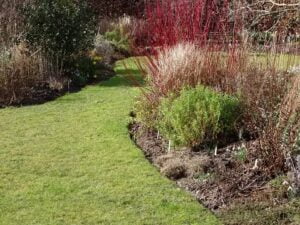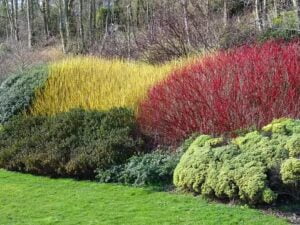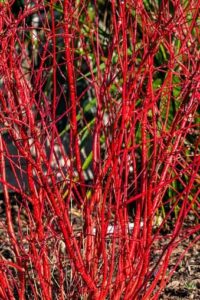Introduction
This in-depth tutorial will cover red twig dogwood care and will arm you with useful knowledge and advice to keep your red twig dogwood plants healthy and vibrant. This article will provide you with the knowledge necessary to grow and care for magnificent red twig dogwoods in your garden or landscape, regardless of your level of gardening expertise. So let’s start right now!
Learning about Red Twig Dogwoods
How do you define Red Twig Dogwoods?
Red twig dogwoods (Cornus sericea) are admired for their gorgeous red or purple stems, which offer a dramatic splash of color to the winter environment. These indigenous plants of North America are frequently seen in marshes, by streams, and in other damp places. Red twig dogwoods produce clusters of tiny white blooms in the spring, followed by lovely berries that serve as food for birds, in addition to their gorgeous winter stems.
Various Red Twig Dogwood species
Red twig dogwoods come in a number of well-liked types, each having special qualities of their own. Several notable variations consist of:
- Cornus sericea ‘Cardinal’: This cultivar is well-known for its intense winter colour and has bright crimson stems.
- Cornus sericea ‘Baileyi’ variety, sometimes known as the red osier dogwood, has vivid red stems and is very beneficial to wildlife.
- Cornus sericea ‘Flaviramea’: This variety stands out due to its stems, which are a bright yellowish-green color in winter.

Benefits of Red Twig Dogwood Plantation
Red twig dogwoods are a great addition to any garden or landscape because they provide a number of advantages. Here are a few significant benefits:
Winter Interest: During the winter, when many other plants go dormant, the vivid scarlet or purple stems of red twig dogwoods offer a much-needed splash of color.
Wildlife Habitat: Red twig dogwoods blossoms and berries draw a wide range of birds, butterflies, and helpful insects, increasing biodiversity in your garden.
Erosion control: Red twig dogwoods are a great choice for regions that are prone to erosion because of their extensive root systems, which stabilize the soil.
Low Maintenance: Once established, red twig dogwoods require just minor trimming and maintenance.
Read About: Wing Begonia Care
Establishing Red Twig Dogwoods
Selecting the Best Location
The location of your red twig dogwoods planting is crucial for ensuring their healthy growth and development. Think about the following elements:
Red twig dogwoods do well in full sun to mild shade. Attempt to get six hours or more a day of direct sunlight. The soil has to be wet and well-draining for these bushes. However, they may survive in a variety of soil conditions, including sandy and clay soils. Allow enough room between plants so that their mature growth can be accommodated. It is typically advised to place them 4 to 6 feet apart.
Growing Steps
To effectively plant your red twig dogwoods, follow these instructions:
- Loosen the soil and remove any weeds or grass from the planting area before you begin to plant. Compost or other organic material can be added to the soil to increase fertility and drainage.
- Make a Hole: Create a hole that is broader and a little deeper than the plant’s root ball.
- Place the Plant: Carefully set the red twig dogwood into the hole, making sure it is at the same depth as it was in the nursery or container. To remove air pockets, gently compact the soil around the roots as you backfill the hole.
- Water and mulch: After planting, give the red twig dogwood plenty of water to let the soil around the roots settle. Mulch should be spread out around the plant’s base, maintaining it some distance from the stem. This reduces weed growth, maintains soil temperature, and conserves moisture.

Red Twig Dogwood Care
It’s crucial to give your red twig dogwood care all year long to guarantee their health and vigor. Follow these recommendations for ideal development and vibrant winter color:
Watering Establishment Phase
Red twig dogwoods need regular watering during the first year after planting to develop a sturdy root structure. Once or twice a week, deep water the plants to keep the soil consistently moist but not soggy. Mature Plants: Red twig dogwoods are often tolerant of moderate drought conditions once established. However, it’s crucial to supply additional watering during extended dry spells, especially during the hot summer months.
Pruning
Red twig dogwoods should be pruned before new growth appears, usually in late winter or early spring. This makes the structure of the plant easier to see and doesn’t obstruct blossoming.
Maintenance Pruning: Get rid of any wood that is diseased, damaged, or dead. To enhance airflow and light penetration, trim out congested branches as well.
Renewal Pruning: To promote new stem growth and preserve brilliant color, consider doing renewal pruning every few years. Three-quarters of the oldest stems must be pruned back to the ground to accomplish this.
Fertilization
Organic Matter: To give the red twig dogwood a nutrient-rich base, incorporate organic matter into the soil after planting, such as compost or well-rotted manure. Early spring is the best time to apply a balanced slow-release fertilizer designed especially for shrubs. For the right dosage and application, refer to the package instructions.
Color Enhancement for Winter
Sun Exposure: Make sure your red twig dogwoods get enough sunlight to intensify the color of their winter stems. The brightest red or purple stems are produced with support from full light exposure.
Pruning Methods: As was already indicated, renewal pruning can encourage the development of fresh, more vivid stems. You can refresh the plant’s appearance by occasionally pruning older, less vibrant branches.
Disease and Pest Management
Monitoring: Keep an eye out for any signs of pests or illnesses on your red twig dogwood. Aphids, powdery mildew, and leaf spot infections are typical problems. If a problem is found, take the necessary steps to control it, such as applying organic insecticides or fungicides.
Additional Advice
Follow this advice for Red Twig Dogwood Care additionally:
Mulching: Keep an organic mulch layer around the base of the plants to retain moisture, control weeds, and act as insulation in extremely cold or hot weather.
Winter Protection: If you live in an area with a harsh winter, you might want to give your red twig dogwoods some protection. Winter damage can be avoided by covering the stems with burlap or by covering them with evergreen boughs.

Conclusion
Red twig dogwoods are lovely, adaptable shrubs that give your yard year-round appeal. These plants are an excellent addition to any landscape because of their beautiful winter stems, lovely flowers, and wildlife value. You can make sure that your red twig dogwoods develop successfully and live a long time by following the maintenance advice provided in this thorough guide. To keep your plants healthy and vibrant, remember to provide adequate watering, execute timely trimming, and apply appropriate fertilizing. You may prolong the beauty of red twig dogwoods in your garden by making these efforts.


